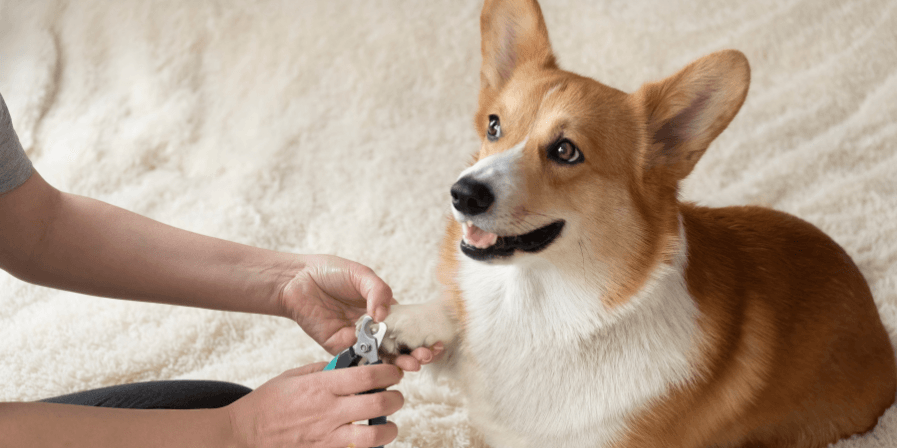Dog Nail Trims: Tips to Avoid Accidents!

Imagine walking around all day in shoes that are too tight, pressing against your toes with every step. That’s how an overgrown nail can feel for your dog—uncomfortable and even painful.
Nail trims aren’t just a cosmetic part of grooming; they’re essential for your dog’s mobility, posture, and overall health. However, many pet owners hesitate when it comes to nail trimming, fearing they’ll accidentally hurt their furry friend. The good news is that with the right techniques, tools, and a little patience, you can make nail trims a stress-free experience for both you and your dog.
Understanding Your Dog’s Nails Before you pick up the clippers, it’s essential to understand the anatomy of your dog’s nails. Think of a dog’s nail like a pencil—there’s an outer shell (like the pencil’s casing) and an inner core (similar to the lead). The inner core, known as the “quick,” contains blood vessels and nerves, making it highly sensitive. Accidentally cutting into the quick can cause pain and bleeding, which is why it’s crucial to trim with caution.
For dogs with light-colored nails, the quick is often visible as a pinkish section inside the nail. This makes trimming easier, as you can see where to stop. However, for dogs with dark nails, the quick is hidden, making it trickier to judge the safe cutting zone. The best approach is to trim small amounts at a time and look for a grayish or pink oval appearing at the center of the cut surface—this signals that you're approaching the quick and should stop trimming.
Choosing the Right Tools
Using the right tools can make a significant difference in how comfortable and safe the trimming process is. Investing in high-quality nail clippers designed for dogs ensures a smoother and safer experience. Scissor-style clippers work well for larger dogs with thicker nails, while guillotine-style clippers are better suited for small to medium-sized dogs with thinner nails. Regardless of the type, the blades should always be sharp, as dull clippers can crush the nail instead of making a clean cut.
Having styptic powder or cornstarch nearby is essential in case of accidental cuts. If the quick is trimmed, applying styptic powder helps to stop the bleeding quickly. If you don’t have it, a clean cloth with gentle pressure can also help control the bleeding.
Creating a Calm Environment for Nail Trimming
Most dogs won’t naturally enjoy having their nails trimmed, especially if they associate the process with discomfort. Creating a stress-free environment can make a significant difference. Choose a quiet, familiar space where your dog feels relaxed. Speak in a soothing voice and offer gentle petting before you begin. Some dogs respond well to distractions like treats, peanut butter spread on a lick mat, or their favorite toy. If your dog is particularly anxious, introducing them to the process gradually can help. Let them sniff the clippers, gently touch their paws, and reward them for staying calm. Over time, they will start associating nail trims with positive experiences.
How to Trim Your Dog’s Nails Safely
Once your dog is comfortable, it’s time to begin trimming. Gently hold their paw and isolate one toe at a time. Position the clippers at a slight angle, following the natural curve of the nail. Instead of making one large cut, trim small sections gradually. If your dog has dark nails, proceed with extra caution, checking the cross-section after each cut to ensure you’re not too close to the quick.
Some dogs might pull away or resist during the process, and that’s perfectly normal. The key is to remain calm and patient. If they become too restless, it’s better to take a break and try again later rather than forcing the process. Some dogs tolerate only one or two nails being trimmed at a time, which is completely fine. The goal is to make the experience as positive as possible so that future trims become easier.
Dealing with Accidents and Bleeding
Even experienced groomers occasionally cut the quick, so if it happens, don’t panic. The best response is to stay calm and act quickly. If you notice bleeding, apply styptic powder or cornstarch to the nail to help clot the blood. If you don’t have either, pressing a clean cloth against the nail for a few minutes should stop the bleeding. Your dog might be startled by the incident, so offer comfort and reassurance, speaking gently to help them relax. If they seem too stressed, it’s best to stop the session and continue another day.
Alternative Methods to Nail Clipping
If your dog dislikes nail clippers, there are alternative methods to maintain proper nail length. Nail grinders are a great option, as they slowly file down the nails rather than cutting them. They are especially useful for dogs with thick nails or those who don’t tolerate the pressure of clippers. Another effective method is a nail board, which allows dogs to file their own nails by scratching on a textured surface. While these methods require some training and patience, they can be excellent solutions for dogs that are fearful of traditional nail trimming.
When to Seek Professional Help
Not every dog will tolerate nail trims at home, and that’s okay. If your dog becomes overly anxious, aggressive, or simply refuses to cooperate, seeking help from a professional groomer or veterinarian is the best option. Professionals have experience handling nervous pets and can safely trim nails without causing unnecessary stress.
At DCC Animal Hospital & Petcare in Gurgaon, we understand that nail trims can be a stressful experience for both pets and their owners. As one of the best veterinary hospitals in Delhi NCR, we offer expert grooming and nail care services designed to keep your pet comfortable and anxiety-free. Our experienced veterinarians and trained groomers use gentle handling techniques, ensuring that even the most nervous pets feel safe during their grooming sessions. To book an appointment, visit DCC Animal Hospital & Petcare.
Final Thoughts
Regular nail trims are not just about aesthetics—they are crucial for your dog’s comfort, mobility, and overall health. Overgrown nails can lead to joint pain, altered posture, and even injuries. By taking the time to introduce your dog to the process gradually, using the right tools, and maintaining a calm environment, you can make nail trimming a positive experience.
If your dog struggles with nail trims, don’t be discouraged. Every dog is different, and patience is key. With time, gentle handling, and positive reinforcement, your dog will learn to tolerate, if not enjoy, this essential grooming task. And if at-home trimming isn’t working, there’s no shame in seeking professional help. What matters most is ensuring that your dog stays comfortable, pain-free, and healthy—one trim at a time.
Frequently Asked Questions
1. How often should dog nails be trimmed?
Dog nails should generally be trimmed every 3 to 4 weeks, but this can vary based on their activity level and nail growth rate. If you hear clicking sounds when your dog walks on hard surfaces, it's time for a trim.
2. Is nail clipping good for dogs?
Yes, regular nail clipping is essential for a dog’s health. Overgrown nails can cause discomfort, affect posture, and even lead to joint problems. Keeping nails properly trimmed helps maintain mobility and prevents painful injuries.


 How can we help?
How can we help?